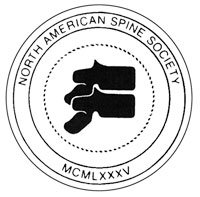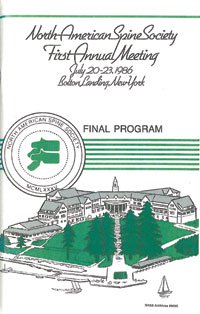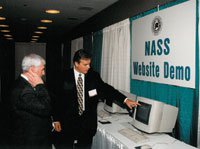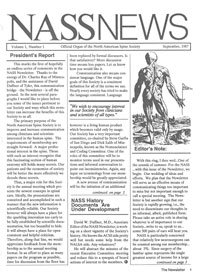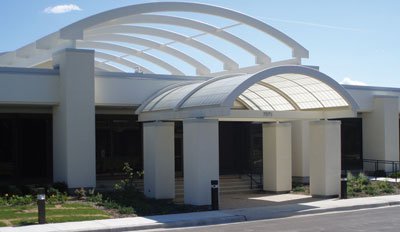From formation to present day, focus of NASS is a broader scope
The beginnings of the North American Spine Society have given way to an explosion in growth.
Devised from a need for a professional specialty society focusing on the spine and forged through small meetings held around the country, the North American Spine Society has always been about expanding its umbrella to cover all areas of spine treatment.
During its 27 years, the North American Spine Society (NASS) has seen historic gains in membership and meeting attendance. Many within the society’s history, including its current executive director, Eric Muehlbauer, MJ, CAE, attribute this growth to its multispecialty approach.
“We have orthopedic surgeons, neurosurgeons, physiatrists, anesthesiologists, pain management specialists and other specialties all teaching one another what they know about spine care,” Muehlbauer told Orthopedics Today. “The result is a more well-rounded, better educated individual.”
That multispecialty approach has its roots in leadership that, from the beginning, saw the need for a varied approach to dealing with issues of the spine.
No easy path
Scott Haldeman, MD, PhD, DC, was deeply involved in the process that would eventually give rise to NASS — becoming its president in 1989. While the need for a spine society was clear in the late 1970s and early 1980s, there was no easy path to achieving this outcome. Specialty societies were being formed around the world, and at that time, the premier spine society was the International Society for the Study of the Lumbar Spine (ISSLS). ISSLS, however, had a limited membership and only held every third meeting in North America, Haldeman noted.
|
|
Images: North American Spine Society |
“It became clear there was no organized forum for presenting research and to offer spine education programs in North America,” Haldeman told Orthopedics Today. “The first attempt to organize a formal education program was called ‘Challenge of the Lumbar Spine.’ A number of researchers and leading clinicians, most of whom were members of ISSLS, started traveling around the country putting on symposia.”
Though it was a step in the right direction, Haldeman noted Challenge of the Lumbar Spine lacked the structure necessary to gain a national foothold.
“It was loosely formed and had no real organization,” he said. “Each person just said ‘Okay, I will do the next meeting,’ and we organized these meetings through the support of our universities.”
Challenge of the Lumbar Spine operated from 1978 to 1989, but when efforts to get ISSLS to become more actively involved in North America in the early 1980s did not work as well as Haldeman and colleagues hoped, it became clear that an organized group for the education and presentation of spine research in North America needed to be spearheaded.
“That is when the organization started to form,” Haldeman said.
|
|
Amalgamation of societies
The 1984 Annual Meeting of the American Academy of Orthopaedic Surgeons (AAOS) resulted in the formation of two spine societies: the North American Spine Association (soon changed to the North American Lumbar Spine Association) and the American College of Spinal Surgeons. John P. Kostuik, MD, — who would go on to serve as NASS president in 1991 — was a member of the American College of Spinal Surgeons Board of Directors.
The existence of two growing spine societies presented a rare opportunity, and the upper levels of AAOS management suggested a merger.
“There was some concern at the presidential level of the AAOS as to how they could support two different organizations,” Kostuik told Orthopedics Today. “They sort of recommended they amalgamate, and that occurred.”
In July 1985, the new organization — NASS — was created. Leon L. Wiltse, MD, was briefly the first president who, at the first meeting, turned the presidency over to William Kirkaldy-Willis, MD, and J. Elmer Nix, MD, served as vice president.
“When they started forming NASS, it was decided that it was going to be all-inclusive and open to all physicians who treated patients with spinal disorders,” Haldeman said. “As a neurologist and non-surgeon, I was invited to join NASS to promote the multidisciplinary goal of the society. It was a deliberate decision by the founders of NASS that this should be a spine society, not a surgical society.”
|
|
As NASS grew in the late 1980s and early 1990s, it began to expand its focus to cover education and the distribution of information presented at its annual meetings. This expansion was furthered in reach and relevance by Kostuik, who began broadening the society’s range in focus toward politics, guideline development and the transition to a more “all-encompassing” association during his presidency.
Kostuik recommended that NASS no longer act as a surgical society and accept all individuals who provided spine care on a professional basis.
“The reason I recommended that at that time was I was concerned there would be a growing dichotomy between surgeons and non-surgical caregivers, and there would be a lack of communication and that evolved into a total spine society,” Kostuik said.
Moving into the present day
From the early 1990s to the present, Muehlbauer, who became executive director of NASS in 1994, noted that the difference in the society is “like night and day.”
“We had three and a half staff when I started, and now we are up to 50,” he said. “We had 850 members, and now we are up to 6,700. The funny thing is the first meeting I was at, we had 620 people. We had an outside consultant as our meeting planner, and she said, ‘Eh, the annual meeting will not grow too much more than this.’ I thought to myself, ‘Well, we will see about that.’”
According to Muehlbauer, NASS has grown more rapidly in recent years.
“We will probably go over 1,000 new members in 2011, which is our biggest year ever,” he said. “I think we will be up to 10,000 members in the next 5 years.”
The change is obvious to those who have attended the meetings since the early 1990s — like Michael H. Heggeness, MD, PhD, the society’s incoming president for 2012.
“It is almost unrecognizable,” Heggeness said of the NASS of today compared to the society years ago. “I think it has grown in every direction and even defined some new ones … We are now at a point where for many spine specialists, both nonoperative and operative, we are the place to go — first, second and third — for information about the spine and as a forum for exchange of information about the spine. Our focus on science, and on evidence-based medicine will continue.”
Among the most important NASS accomplishments currently underway, according to Heggeness, is the society’s expansion into international prominence.
|
|
“An important constituency within NASS is our international members,” he said. “We are now seeing a significant and continually growing presence of international attendees at the meeting. They come from all over the world and now comprise over 20% of the people who come to the meeting.”
“We are now probably at a place where many spine specialists in Europe, South America and Asia are regarding us as the authoritative dispensers of research and other clinical information throughout the world,” he added, noting one of the projects for his presidency is encouraging a greater international presence for NASS. This will include increased co-sponsoring of meetings that are held internationally.
“This is something that I feel is important from a lot of perspectives; it is almost as if we may outgrow our choice of name,” Heggeness said. “I am hoping that we do.”
What the future holds
As for the future, the consensus among those interviewed is apparent: the society will continue to grow.
“NASS has become the focus of all spine research and spine clinical training in North America,” Haldeman said. “In my opinion, if you want to claim that you are up to date in spine care and are a spine specialist as opposed to just somebody treating backs … if you want to claim that the spine is your area of expertise, you must be a member of NASS. If you are not a member of NASS and you do not attend NASS meetings, you are not up to date. There is nowhere else you can keep abreast of the latest developments in spine care in North America.” – by Robert Press

- Scott Haldeman, MD, PhD, DC, can be reached at 801 N. Tustin Ave., #202, Santa Ana, CA 92705-3600; 714- 547-9822; email: haldemanmd@aol.com.
- Michael H. Heggeness, MD, PhD, can be reached at 6620 Main Street #1325, Houston, TX; 713-986-6000; email: heggeness@bcm.edu.
- John P. Kostuik, MD, can be reached at 571-594-7419; email: jkostuik@k2m.com.
- Eric Muehlbauer, MJ, CAE, can be reached at 7075 Veterans Blvd., Burr Ridge, IL 60527; 630-230-3600; email: emuehlbauer@spine.org.
- Disclosures: Haldeman, Heggeness, Kostuik and Muehlbauer have no relevant financial disclosures.

